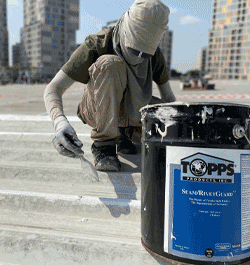UP TO THE MINUTE
Worker Health and SPF Chemicals

By General Coatings.
Practical information about potential worker exposure to SPF chemicals and recommendations for trade worker safety.
Spray Polyurethane Foam (SPF) is widely used to insulate buildings to give them greater energy efficiency. SPF is spray applied, on site, as a liquid and quickly reacts to form polyurethane foam that binds to the building substrate and expands to fill small gaps and cracks in the building envelope. Recently, people have questioned the potential chemical emissions and possible health risks of SPF since it forms on-site.
Current SPF safety
SPF manufacturers recommend workers and building occupants adhere to reentry and reoccupancy times in areas where their products are applied. These times are designed to provide for the safety of trade workers and building occupants.
Industry practice emphasizes the importance of having unprotected trade workers adhere to the manufacturer recommended reentry time and ventilation process, and the general public or building occupants adhere to the manufacturer recommended reoccupancy guidance. Normally, reoccupancy times have building occupants wait a minimum of 24-hours after application of high-pressure SPF to reoccupy the area, but recommendations may vary.
Reoccupancy times are generally most applicable to retrofit applications of SPF. Given that SPF is often installed in new construction significantly before the home is occupied, reoccupancy times are generally not as relevant for production building.
Reentry time is the time elapsed after the installation of SPF in a building when it is deemed safe for SPF applicators, helpers and other trade workers to enter the building and resume operations without the need for personal protective equipment (PPE).
Trade worker re-entry study
Since 2010, the American Chemistry Council’s Center for the Polyurethanes Industry (CPI) has been engaged in a three-tiered work plan to expand the spray polyurethane foam (SPF) industry’s product stewardship program. Work is on-going to develop a full-scale spray booth standard method that can be used to measure SPF emissions during application. SPF manufacturers will be able to use the results of his method to set appropriate worker reentry times. Data emerging from these research projects has shown that emissions from SPF are generally low, and below levels expected to cause harm to workers or building occupants – after the appropriate reentry and reoccupancy times have elapsed.
The purpose of the Trade Worker Re-entry Study was to provide a method for generating air monitoring data that could be used to determine reentry times for trade workers (that is, workers not involved in SPF application) following SPF application. During the project, air monitoring was conducted in a ventilated spray room to measure chemical emissions from the three generic SPF formulations beginning one hour after SPF application. Air sampling was then repeated periodically throughout a 12-hour period.
The results showed that MDI reacts quickly and is not detected shortly after SPF application. However, some chemical components in the “B-side” or polyol blend may emit from the insulation product and should be evaluated to determine when it is appropriate for other trade workers to return to the work area. Chemical emissions from SPF insulation after application can vary depending on ventilation rates in the area where the SPF was applied and the SPF chemical formulation. Work is on-going at ASTM to develop a consensus standard, based on the large-scale emissions project.
Potential health effects may result if workers are exposed to SPF chemicals by skin contact or if airborne concentrations are in excess of occupational exposure limits (OELs). Worker exposure to SPF may occur as chemicals are handled during set-up and clean-up, SPF application, or in the event of a chemical spill. Post-spray emissions from cured SPF have been shown to be generally very low, below concentrations anticipated to cause adverse health effects to workers.
However, it is important to follow manufacturers’ recommended reentry times to determine when it is safe for other trade workers to return to areas where SPF has just been applied without wearing PPE. It is also important for members of the general public to follow recommended reoccupancy times to determine when it is safe enter the work area after SPF application.
Trade worker safety
Because application of SPF insulation involves the use of a spray gun, both chemical vapors and spray mist particles are a source of potential exposure for workers. The vapors and spray mist generated during spray application are an inhalation (breathing) and skin or eye contact hazard. MDI is typically the greatest concern during spray application for workers.
It is essential that the applicator spraying foam wear personal protective equipment that includes chemical resistant gloves, full body disposable clothing, and respiratory protection. Although MDI has potential hazards, it reacts quickly with the polyol to form the polyurethane foam and is no longer present in its original form within the final product (similar to an egg not being present in a baked cake). Other chemicals such as the flame retardant, amine catalysts and blowing agents may also be present at elevated concentrations during application.
Protective equipment used by the applicator for protection against the potential exposure of MDI will also help protect workers against the potential exposure to other SPF chemical components. The U.S. Environmental Protection Agency’s (EPA) Ventilation Guidance for Spray Polyurethane Foam Application recommends general ventilation practices, such as opening doorways and windows, and the use of mechanical ventilation, such as exhaust fans or blowers, to lower concentrations of chemical emissions during SPF application.
It is a good practice to continue to ventilate the SPF application area after installation of the product, while the SPF contractor may be conducting post clean-up activities. Many applicators will ventilate the area for at least one to two hours. Even with the use of ventilation control measures, it is important to restrict unprotected workers and other non-trade workers from entering the SPF work area during and after application until the prescribed reentry time.
Conclusion
The use of trained professional applicators who employ proper workplace controls such as ventilation and PPE has been a successful component to controlling exposure risks. As part of a well-designed approach, other trade workers and homeowners remain well away from the SPF application work area during and for a period of time after SPF application.
Trade workers should adhere to manufacturer recommended reentry times prior to reentering the SPF work area. Airborne MDI concentrations have been shown through monitoring tests to be well within OELs shortly after SPF application. Other SPF components may emit at low airborne concentrations for a period of time after the product has been installed.
One of the most successful ways to manage exposure potential associated with SPF’s application and indoor air quality post-application is to hire a trained professional to apply SPF according to the manufacturer’s recommendation.
With good ventilation practices, airborne concentrations of these other chemicals have been demonstrated to be below levels anticipated to cause concern to workers or building occupants. Installing SPF in a home helps to seal the structure and reduce airflow. Proper mechanical ventilation is needed to maintain a healthy living space and is key to sustained indoor air quality.
Learn more about General Coatings in their RoofersCoffeeShop® Directory or visit www.generalcoatings.net.



















Comments
Leave a Reply
Have an account? Login to leave a comment!
Sign In